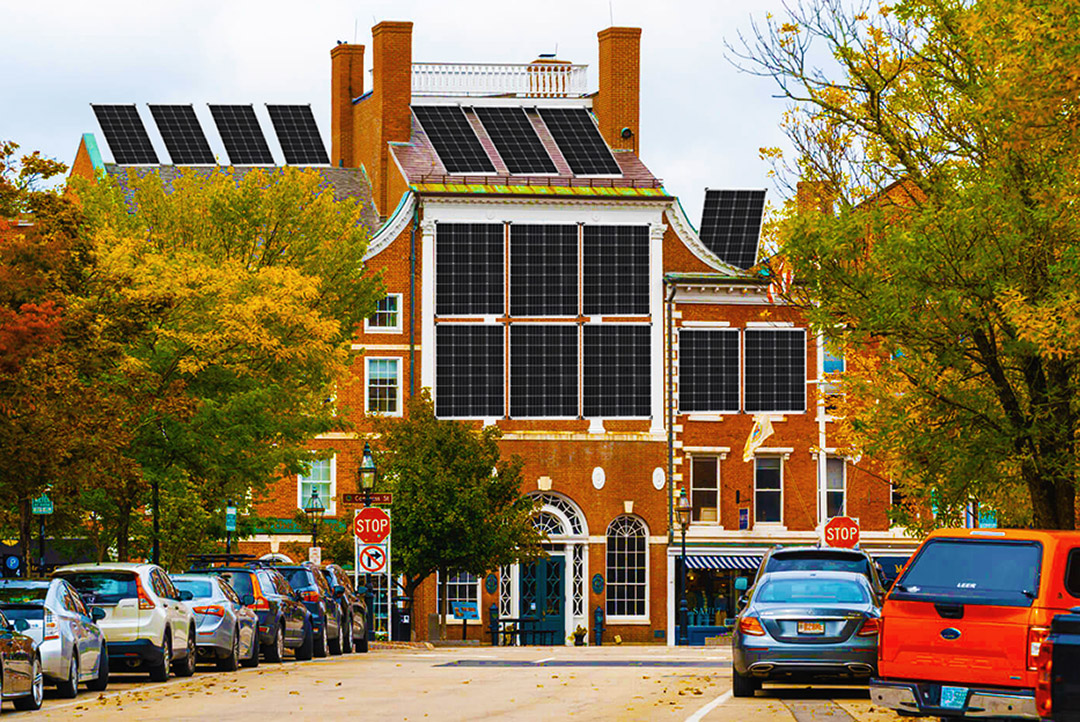By William Whipple VIII
Portsmouth is “an old town by the sea.” It is defined by its maritime past and its long history, and people from around the world marvel at its rich architectural heritage.
Portsmouth preservationists have much to be proud of – and, perhaps, much to be concerned about, given the pace of development and proposed changes to the Historic District Commission’s authority.
On January 16, the City Council passed Councilor Denton’s motion to refer to the planning board amendments that would remove the requirement for the Historic District Commission to approve solar panels and the hardware required for them.
The motion passed unanimously, despite concerns expressed by some Councilors. The Council also voted to request a work session between the planning board and the HDC.
Reagan Ruedig, the recently elected chairperson of the HDC, addressed the Council, and hoped the City would “not risk any sort of threats to our historic district and our historic resources, because they are just as important” as climate change concerns.
Councilor Denton stated that since it is not required by law, homeowners should not have to go before a review board to install solar panels. His motion would permit the use of solar panels and associated hardware without the approval of the HDC.
Councilor Blalock said that the HDC had been established “mainly to prevent structures from being knocked down.”
What’s a historic resource, anyway?
It’s worth noting that the purpose of the historic district goes far beyond restraining wrecking balls. Consider the definition of a Historic Resource, taken from the City of Portsmouth’s Historic Commission Guidelines:
“Definitions • Historic Resource: An individual building, structure, site, object or district that has been determined to have historical significance or associations and whose distinctive character conveys a unique architectural and cultural heritage.”
Buildings in the historic district possess important historical and cultural significance. They aren’t just pretty old buildings to look at – they represent a real connection to the past, to the people and influences that shaped the community.
Furthermore, it is their “distinctive character,” their unique architectural qualities, not their mere presence, that define them as resources. Altering their appearance does impact their value as historic resources.
Councilor Lombardi acknowledged this when he said that part of the value of a property in a historic district belongs to the community. He added that changes to the character of a house diminish the value to the community.
How much would solar panels help?
Councilor Cook noted that placing “solar panels on homes in the historic district is not going to make as big a difference as people think.” She suggested that individuals owning homes in the historic district go online and opt up to 100 percent renewable energy through Community Power.
(The City passed up its opportunity to “opt up” to Community Power last year, citing higher costs and an apparent unreadiness on the part of Community Power, but that’s another story.)
So just how much of a difference would solar panels make?
Consider that Eversource gets its electricity from the New England Power Grid. The grid sources much of its electricity not from coal – loathsome to most environmentalists – but from natural gas, mostly, along with other sources, such as nuclear and renewables.
This table shows the sources for power in the New England Power Grid in gigawatt hours (GWh).

Natural gas is not green energy. It does account for the release of methane and CO2 into the atmosphere. It is, however, a lot better than some alternatives.
Consider the following statement from the US Energy Information Administration:
“Burning natural gas for energy results in fewer emissions of nearly all types of air pollutants and carbon dioxide (CO2) than burning coal or petroleum products to produce an equal amount of energy. About 117 pounds of CO2 are produced per million British thermal units (MMBtu) equivalent of natural gas compared with more than 200 pounds of CO2 per MMBtu of coal and more than 160 pounds per MMBtu of distillate fuel oil.”
The grid’s energy sources may not be perfect, but they could be worse.
Other concerns
New Hampshire’s utility companies, including Eversource, offer net metering to customers who own solar panels. This means that homeowners with solar panels earn credits with their utility provider when the panels generate excess electricity.
There is a potential dark side to this sunny practice. Many people concerned with social justice have pointed out that net metering means that utility customers without solar panels – usually those with the lowest household incomes – end up subsidizing those who can afford them.
Would anyone really notice?
It’s worth mentioning that due to the comparatively low amount of sun exposure in New England, the number of solar panels required to generate enough electricity for the typical home is not insignificant. A solar array large enough to generate the average 30 kwh of power per day for a home would require 25 solar panels rated at 300 watts.

Each of these panels is 3 feet by 5 feet. With 25 of them on a building, let’s just say you’d notice it.
There are 1200 buildings in the historic district. It is safe to assume that not all owners of these properties would wish to add solar panels.
If, say a third of them added solar panels, would the removal of 400 homes from a power grid that is already free from dependence on coal, and generates some of its power from renewable sources, make a substantial difference?
Or would it be a mere moral victory, a symbolic statement? For the permanent alteration of a historic district – which defines the City and draws thousands of visitors – is it worth it?











